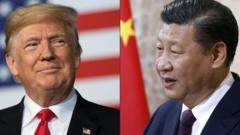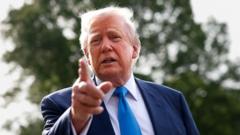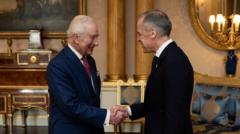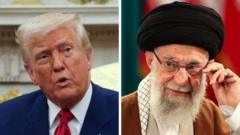As tariffs escalate in the US-China trade war, both nations find themselves engaged in a delicate balancing act of potential negotiations, each unwilling to show signs of desperation. The clock ticks on whether they will initiate talks to de-escalate tensions or continue a game of diplomatic chicken.**
US-China Trade War: Will Talks Emerge or Continue the Stalemate?**

US-China Trade War: Will Talks Emerge or Continue the Stalemate?**
The ongoing trade war between the US and China reaches a critical juncture as both nations signal a potential openness to discussions while trying to avoid the appearance of weakness.**
In the early hours of Thursday, a report from Chinese state media ignited global interest by revealing that the United States is pursuing talks related to the ongoing tariff war. The revelation comes as trade between the US and China is severely impacted by unprecedented tariffs, reaching as high as 245% on certain Chinese exports. With rising recession fears looming over both economies, urgency for dialogue has grown.
The social media account Yuyuantantian, linked to China Central Television, stated that unnamed sources indicated multiple communication channels have opened between Washington and Beijing. This announcement follows President Donald Trump’s previous claims that discussions were already in progress, a notion later rebutted by Chinese officials. The post added, "China has no need to engage with the US," suggesting that the US is currently more anxious for negotiations.
Characterizing the situation as a strategic stalemate, experts suggest that both Trump and Chinese President Xi Jinping are reluctant to appear vulnerable by being the first to reach out formally for talks. "It's like two drivers racing towards each other—whichever one swerves first is deemed weak," remarked Ja Ian Chong from the National University of Singapore. The outcome sought by both leaders—a de-escalation of the trade war—creates an intricate and tense atmosphere as neither desires to yield.
This deadlock appears to be fueled by a concept known as "constructive ambiguity," where vague comments allow each side to claim righteousness. Observers note that the latest statements from Chinese media can be seen as a way to navigate out of this escalating scenario without losing face.
One possible resolution route involves an impartial mediator that might facilitate discussions without compromising either side’s position. Alternatively, both nations may adopt looser definitions of "outreach," allowing them to negotiate without explicitly conceding. This approach enables both leaders to claim victories upon entering discussions, preserving their images domestically.
For Trump and Xi, delivering a favorable narrative to their domestic constituencies is essential amid economic tensions. Trump aims to showcase a hardened stance against China, asserting that Beijing must give in to his demands. Xi faces pressure as he navigates a foliage of economic challenges, including sluggish consumption and high unemployment, necessitating a strong front against US tariffs.
Both leaders seem to acknowledge that the trade war is complex; a total victory for either side is improbable. Trump appears to be moving towards a middle ground, seeking meaningful concessions that he can present as successes to the American public. Meanwhile, China is cautious, closely considering what sacrifices they may need to make without undermining their own authority.
As of now, the US has not refuted China's claim of initiating potential talks, leading to speculation about some level of engagement. However, despite these inklings of discussions, experts warn that significant relationship stabilization between the two countries is far from assured. Many believe there’s a lingering atmosphere of posturing and that neither party is prepared to compromise until they can ascertain the other's willingness to blink. The next steps in this gripping trade battle remain uncertain, with international observers watching closely.
The social media account Yuyuantantian, linked to China Central Television, stated that unnamed sources indicated multiple communication channels have opened between Washington and Beijing. This announcement follows President Donald Trump’s previous claims that discussions were already in progress, a notion later rebutted by Chinese officials. The post added, "China has no need to engage with the US," suggesting that the US is currently more anxious for negotiations.
Characterizing the situation as a strategic stalemate, experts suggest that both Trump and Chinese President Xi Jinping are reluctant to appear vulnerable by being the first to reach out formally for talks. "It's like two drivers racing towards each other—whichever one swerves first is deemed weak," remarked Ja Ian Chong from the National University of Singapore. The outcome sought by both leaders—a de-escalation of the trade war—creates an intricate and tense atmosphere as neither desires to yield.
This deadlock appears to be fueled by a concept known as "constructive ambiguity," where vague comments allow each side to claim righteousness. Observers note that the latest statements from Chinese media can be seen as a way to navigate out of this escalating scenario without losing face.
One possible resolution route involves an impartial mediator that might facilitate discussions without compromising either side’s position. Alternatively, both nations may adopt looser definitions of "outreach," allowing them to negotiate without explicitly conceding. This approach enables both leaders to claim victories upon entering discussions, preserving their images domestically.
For Trump and Xi, delivering a favorable narrative to their domestic constituencies is essential amid economic tensions. Trump aims to showcase a hardened stance against China, asserting that Beijing must give in to his demands. Xi faces pressure as he navigates a foliage of economic challenges, including sluggish consumption and high unemployment, necessitating a strong front against US tariffs.
Both leaders seem to acknowledge that the trade war is complex; a total victory for either side is improbable. Trump appears to be moving towards a middle ground, seeking meaningful concessions that he can present as successes to the American public. Meanwhile, China is cautious, closely considering what sacrifices they may need to make without undermining their own authority.
As of now, the US has not refuted China's claim of initiating potential talks, leading to speculation about some level of engagement. However, despite these inklings of discussions, experts warn that significant relationship stabilization between the two countries is far from assured. Many believe there’s a lingering atmosphere of posturing and that neither party is prepared to compromise until they can ascertain the other's willingness to blink. The next steps in this gripping trade battle remain uncertain, with international observers watching closely.



















